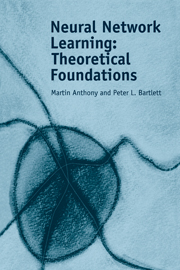Book contents
Preface
Published online by Cambridge University Press: 26 February 2010
Summary
Results from computational learning theory are important in many aspects of machine learning practice. Understanding the behaviour of systems that learn to solve information processing problems (like pattern recognition and prediction) is crucial for the design of effective systems. In recent years, ideas and techniques in computational learning theory have matured to the point where theoretical advances are now contributing to machine learning applications, both through increased understanding and through the development of new practical algorithms.
In this book, we concentrate on statistical and computational questions associated with the use of rich function classes, such as artificial neural networks, for pattern recognition and prediction problems. These issues are of fundamental importance in machine learning, and we have seen several significant advances in this area in the last decade. The book focuses on three specific models of learning, although the techniques, results, and intuitions we obtain from studying these formal models carry over to many other situations.
The book is aimed at researchers and graduate students in computer science, engineering, and mathematics. The reader is assumed to have some familiarity with analysis, probability, calculus, and linear algebra, to the level of an early undergraduate course. We remind the reader of most definitions, so it should suffice just to have met the concepts before.
Most chapters have a ‘Remarks’ section near the end, containing material that is somewhat tangential to the main flow of the text.
- Type
- Chapter
- Information
- Neural Network LearningTheoretical Foundations, pp. xiii - xivPublisher: Cambridge University PressPrint publication year: 1999

